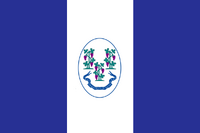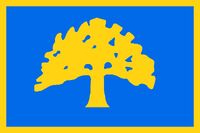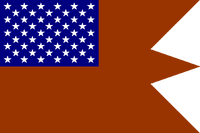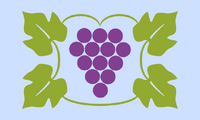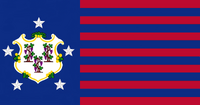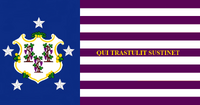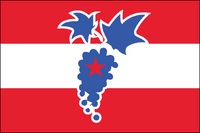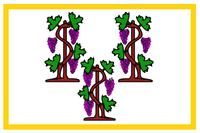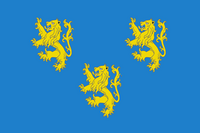No edit summary Tag: Visual edit |
(Editing a gallery) |
||
| Line 71: | Line 71: | ||
Flag of Connecticut (TheMaster001).png|Connecticut Flag Proposal by TheMaster001 |
Flag of Connecticut (TheMaster001).png|Connecticut Flag Proposal by TheMaster001 |
||
US-connjd.png|Connecticut state flag proposal by James Dignan, September 2014, based on the arms of the Say and Sele family |
US-connjd.png|Connecticut state flag proposal by James Dignan, September 2014, based on the arms of the Say and Sele family |
||
| + | conneticut3.png|Green star stands for the charter Oak. The purple for the vines. The blue for the Ocean. The 5 stripes for the order of admission. The white for the constitution. Design by Rotten Ali. |
||
</gallery> |
</gallery> |
||
Revision as of 13:03, 2 December 2017
| This page uses Creative Commons licensed content from Wikipedia. (view authors) |
The flag of the state of Connecticut consists of a white baroque shield with three grapevines (each bearing three bunches of purple grapes) on a field of azure blue. The banner below the shield reads "Qui Transtulit Sustinet" ("He who transplanted still sustains"), the state's motto.
The Connecticut General Assembly approved the flag in 1897 after it was introduced by Governor Owen Vincent Coffin in 1895.
The design comes from the seal of Saybrook Colony when it was established in 1639. That seal depicted 15 grapevines and a hand in the upper left corner with a scroll reading "Sustinet qui transtulit". When Connecticut Colony bought Saybrook in 1644, the seal transferred to Connecticut Colony. On October 25, 1711, the governor and legislature changed the seal. They reduced the number of grapevines from 15 to three, in order to represent the three oldest settlements (Windsor, Wethersfield, and Hartford) (or possibly the three separate settlements, Connecticut Colony, Saybrook Colony, and New Haven Colony, which had been absorbed into Connecticut by that time) and rearranged the wording and position of the motto.
Proposals for a New Flag of Connecticut
Shown below are various designs for a proposed new flag of Connecticut.
Most common symbolism
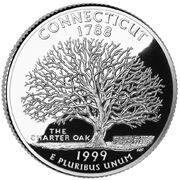
Connecticut state quarter
Besides the grapevines from the state seal, the most common symbol is the Charter Oak. According to tradition, Connecticuters hid their colony's charter inside a giant oak tree in Hartford to prevent its falling into the hands of Sir Edmund Andros, who had been sent by King James II to impose stronger royal control. The oak became a symbol of Connecticut's independence. It is the dominant symbol on its state quarter.













